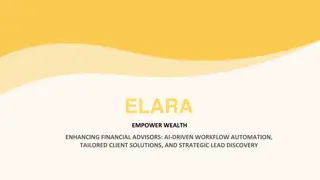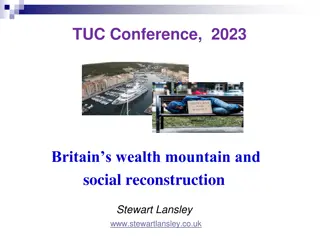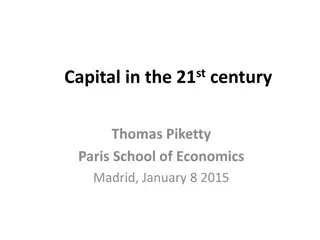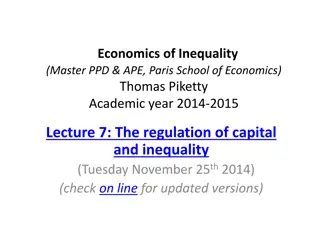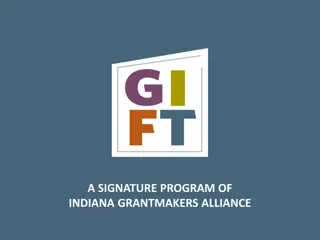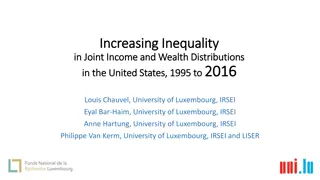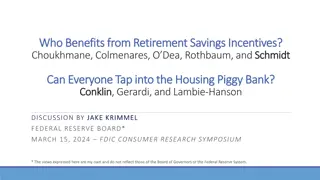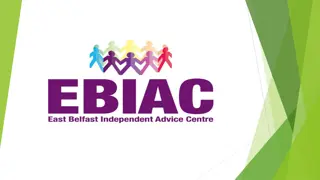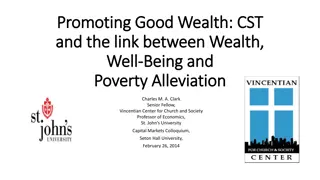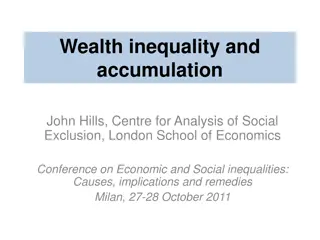Understanding Community Wealth Building for Socially Just Economies
Community Wealth Building focuses on fairer, socially just economies through progressive concepts like anchor institutions, plural ownership, and fair labor markets. It promotes broad ownership and distribution of wealth for national and international benefits, including productivity, social, and environmental gains. The approach works to address economic challenges in areas affected by underinvestment, austerity, financialization, and automation, highlighting its significance in shaping a more inclusive economy.
Download Presentation

Please find below an Image/Link to download the presentation.
The content on the website is provided AS IS for your information and personal use only. It may not be sold, licensed, or shared on other websites without obtaining consent from the author. Download presentation by click this link. If you encounter any issues during the download, it is possible that the publisher has removed the file from their server.
E N D
Presentation Transcript
COMMUNITY WEALTH BUILDING
What is Community Wealth Building? Anchor institutions Plural ownership of the economy Making financial power work for local places Fair employment and just labour markets CONTENT Progressive procurement of goods and services Socially just use of land and property Challenges Community Wealth Building works It s already happening in Scotland Further opportunities
Community wealth building is about creating a fairer, more socially just economy. It is practical action, framed by progressive concepts.
Community Wealth Building in the UK
Scottish Government Scotland s Centre for Regional Economic Growth (SCRIG) Community Wealth Building in Scotland Scottish Local Authorities Economic Development (SLAED) Ayrshire Growth Deal
Video: What is Community Wealth Building?
ANCHOR INSTITUTIONS Large commercial, public and social sector organisations Significant stake in a local place Exert sizable influence to generate social value
Community wealth building makes wealth socially helpful by ensuring it is broadly held, owned and distributed It delivers national and international benefits, including Productivity benefits Social benefits Environmental benefits WHAT IS COMMUNITY WEALTH BUILDING? Can work anywhere, but crucial in areas where the economy has been hollowed out through years of under investment Whole systems approach to economic development geared to challenges of austerity, financialisation and automation
OWNERSHIP OECD figures suggest that the UK has amongst the highest levels of income inequality in the European Union. Financial wealth is held by a small minority - 44% of the UK s wealth is owned by just 10% of its population, five times the total wealth held by the poorest half. More than a fifth of the population live on an income below the poverty line, despite the majority of these households being in work In response, community wealth building seeks to promote locally owned and socially minded enterprises. It also seeks to democratise the economy with greater local authority insourcing and development of municipal enterprise.
Public sector insourcing report by the Association for Public Service Excellence (APSE), insourcing on the increase, increasingly viewed as a pragmatic means to address service improvement, service efficiency and to recalibrate local services to local needs. Municipal enterprise In Wrexham, the local authority has implemented a renewable energy scheme, which will rec=dcuce the amount of CO2 emitted by 3,000 tonnes a year and generate up to 1m a year in surplus income for the next 25 years. Worker ownership Preston City Council has led international innovation on the democratisation of the economy, working with UCLAN, local people and organisations to develop a healthy co-operative sector. Community ownership Granby 4 Streets is a community land trust which provides affordable ownership and rental property for residents in Toxteth, South Liverpool.
LOCAL INVESTMENT The UK banking sector is orientated towards global markets rather than local investment and economic development There has been stagnation of lending to small businesses and the closing of many local branches, reducing the connection between lenders, their local communities and personal banking services Access to credit is needed for small businesses to operate Community wealth building seeks to increase flows of investment within local economies. It does this by harnessing the wealth that exists locally - to channel investment to local communities while still delivering a steady and reasonable financial return for investors
The use of local pension funds to support local investment priorities - Preston City Council has already taken steps to ensure that its large public pension investments are utilised for social good, using this money to fund housing development in the city centre. In 2017, Islington Council set about reducing its pension fund s exposure to carbon. It is also investigating how it might support social impact investment, specifically social housing. MAKING FINANCIAL POWER WORK FOR LOCAL PLACES EXAMPLES OF PRACTICE Support for local credit unions and the provision of loans to community groups local government in particular is able to support credit unions in the form of grants or guarantees as well as depositing funds with credit unions that would otherwise be invested with banks.
FAIR EMPLOYMENT Continuing stagnation of real wages, the erosion of job security, the rise of zero-hour contracts and job loss driven by automation, mean that the reality of employment for many in the UK is increasingly precarious Many people working in full time jobs are unable to make ends meet. In 2018, the Joseph Rowntree Foundation calculated that the number of workers in poverty was 4 million, meaning that about one in eight people are now classed as working poor Community wealth building not only aims to improve employment opportunities but wider employment terms and conditions and worker rights - for example, by promoting recruitment from lower income areas, inclusive employment practices, committing employers to paying the Living Wage and by building progression routes for employees.
The real Living Wage - many anchor institutions are now real Living Wage employers, paying a minimum of 9 per hour in the UK and 10.55 per hour in London. FAIR EMPLOYMENT AND JUST LABOUR MARKETS EXAMPLES OF PRACTICE Inclusive employment programmes - numerous anchor institutions have adopted inclusive employment programmes to attract those furthest from the labour market into employment. Leeds Teaching Hospital NHS Trust, run a programme with other local partners to build the confidence of the long term unemployed. They also have a particular focus on promoting careers to young people in the local area, have established a number of health career ambassadors and have a cohort of staff who go into schools in areas of high deprivation
PROCUREMENT When it comes to how money is spent and how services are commissioned by anchor institutions, cost is often the dominant determining factor in who gets the contract. Social value tends to be a weaker consideration. Community wealth building promotes the progressive procurement of goods and services, as this spending power can be a means through which greater economic, social and environmental benefits can be achieved.
Local spending - Prestons efforts to localise social value impact has brought millions of pounds back into the local economy. The recirculation of over 200m being spent with local suppliers as a result of the changes in procurement behaviour across anchor institutions has had a positive multiplier effect on local jobs, wellbeing, health, and economic growth. Social value frameworks - the adoption of a robust social value framework by Manchester City Council, who consistently use 20% social value weighting in their tendering process, has produced significant social and economic impacts. These include creating jobs for the long term unemployed and persons with learning disabilities, as well as support for the third and community sector.
How land and property assets are owned and managed are key features of any local economy. Land ownership ASSETS matters because it is an expression of economic and political power The current state of landownership is a major driver of inequality, as a few private owners benefit from speculation on property markets whilst the majority suffer the consequences of unaffordable house prices In the past anchors would act to ensure that publicly owned land secured benefits for the local community, for example municipal town halls and local parks In recent decades over 2 million hectares of public land has been sold off to private interests Through a community wealth building approach, assets are owned and managed in ways which ensure that they generate wealth for local citizens, as opposed to being enclosed by private interests.
Community asset transfers as part of developing the relationship with the community, the transfer of management/and or ownership of land or buildings from public bodies to the 3rd sector is becoming more and more prevalent. It is an approach that Wigan have utilised extensively as part of the Wigan Deal, which has led to numerous former Council-owned buildings being transferred to community organisations to provide services such as sporting facilities, allotments and libraries. SOCIALLY JUST USE OF LAND AND PROPERTY EXAMPLES OF PRACTICE Using land to support the local community this is an approach that is currently being utilised by University Hospitals Birmingham NHS Foundation Trust who regularly allow local community groups and charities to make use of their buildings and facilities for free, giving over their conference centre to let local charities run annual conferences for example. They also run a local farmers market on their land which is specifically targeted at micro enterprise within a 30-mile radius
CHALLENGES The continued dominance of our current economic model Policy obstacles A lack of strong drivers to encourage community wealth building
COMMUNITY WEALTH BUILDING works the success in Preston presents a proof of concept. By modelling methods of economic development which are founded on harnessing the collective power of public institutions rather than relying on inward corporate investment, Preston has demonstrated that reliance on external investment is no longer the only way is the work of many hands it succeeds when it is a shared endeavour involving many individuals across many organisations must be unique to place creating a bespoke local approach, based on an assessment of local need to identify the unique local circumstances, and working in ways that are most appropriate for local conditions is about public service collaboration across anchor institutions in a locality to produce positive outcomes
COMMUNITY WEALTH BUILDING means a diversity of suppliers progressive procurement work can increase competition, allowing a plurality of providers, including but not limited to local suppliers, to compete and bid. It demands a careful balancing of geographical, social, environmental and other factors. tells a story that people want to hear interest in the Preston Model demonstrates a demand for innovative new ideas is not a model it is an inspiration it should never be a one size fits all policy prescription is both a policy approach and a way of working it is relatively easy for an anchor institution to adopt the five principles of community wealth building as an economic policy, but to animate that policy with other anchor organisations within a place and then to affect a change in business operations takes focus, effort and time
ITS ALREADY HAPPENING IN SCOTLAND Councils as employers, contributing to fair employment and just labour markets - Councils are major employers employing 10%+ of the resident employment base in 1/3rd of councils Councils as procurers, contributing to the progressive procurement of goods and services - Councils spend a substantial part of their procurement budget within their localities. Local spend as a share of total procurement spend varies significantly across councils depending on their local circumstances, the Procurement Reform (Scotland) Act 2014 creates opportunities to develop progressive procurement Councils as asset managers, contributing to socially productive use of land and property - Some 40,000 assets are managed by Scotland s local authorities, including a wide range of land, buildings and infrastructure, there is evidence of a general direction of travel towards a corporate asset management approach linked to social and economic outcomes, at all levels from strategic to local.
ITS ALREADY HAPPENING IN SCOTLAND North Ayrshire Council are Scotland s first Community Wealth Building Council. They have established a CWB Commission and published their Community Wealth Building Strategy The Ayrshire Growth Deal Heads of Terms includes a 3million CWB Fund
OTHER COUNCILS AND CITY DEALS Tay Cities Growth Deal Western Isles Clackmannanshire One of Glasgow City Regional authorities South of Scotland Enterprise
FURTHER OPPORTUNITIES Positive targeting of recruitment / work experience, etc within disadvantaged areas / groups through local government and community planning partners Whilst there is little growth demand in LG employment, replacement demand and future workforce planning provides an opportunity for tackling poverty via recruiting from disadvantaged areas Better Economic Development - Procurement collaboration More strategic / collaborative / aspirational / imaginative approaches to Community Benefits Targeted local procurement alongside supplier development programmes Data improvements to measure local procurement
FURTHER OPPORTUNITIES Asset management could help with holistically developing the place agenda More explicit linkage could be made of assets with economic development priorities e.g. encouraging footfall that promotes commercial sustainability in declining town centres There are opportunities to evolve the asset portfolio to ensure accessibility for disadvantaged populations via physical location and/or transport links Co-location opportunities across CPPs could help with the management of assets and access to those assets Community asset transfer can be further developed to promote community ownership and further local wealth building Co-ordination and cross departmental working between procurement, asset management and economic development teams is required to maximise opportunities in regard to community wealth building.
USEFUL LINKS www.cles.org.uk SLAED Khub


